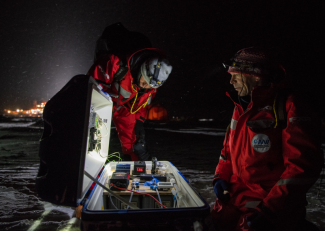
-
Date
by Byron Blomquist, CIRES and NOAA
The Dranitzyn left the coast of Norway yesterday to begin the transit to
our location and should arrive within a week to 10 days. AWI estimates it
will then take about 5 days to transfer ~50 tons of cargo between the two
vessels and pump over the fuel, weather conditions permitting. We expect
the science party will be involved in the cargo transfer since the job
involves quite a bit of manual labor. Then, we turn over the Polarstern
and ice camp to our leg 2 replacements and begin the journey back home.
Hope to be back around the first of the year.
We were not able to accomplish everything we planned for leg 1 and have
had to overcome a series of setbacks related to ice dynamics, but the
accomplishments are still quite impressive and we will be returning with a
lot of data. The route to Met City was reestablished over the past week
and the main power lines reconnected, so most of the instrumentation there
is back on line. The ship's machinists were able to repair some of the
damage to the collapsed 30m met mast and we hope to reinstall it as a 23m
mast sometime over the next week, when the weather conditions ease a bit.
For our project, measurements from the ship bow tower have continued
normally when conditions permit. Wind direction varies in a regular cycle
related to the presence of arctic low and high pressure systems, and this
is evident in our cyclic drift pattern over the past few weeks. Air
sampling from the bow is often good for several days running, then
unsuitable for several days as the wind direction shifts to the stern of
the ship.
The anemometers, CO2/CH4 flux system, fast ozone, slow ozone, NOx, GCMS,
and mercury instruments have all been running well. The DMS mass
spectrometer ran for a few weeks, but a power supply failure will keep
this system off line until leg 4. We have deployed the CO2/CH4 chamber
flux system more than 10 times during leg 1 and are becoming more
confident in our ability to operate it under harsh conditions. Yesterday
was the second deployment of the ozone chamber on the ice near the ship.
Steve has done considerable work to get the DMS chamber sampler running
and to characterize the efficiency of the DMS traps, but we have not yet
had the opportunity to try this system out on the ice.
We will be short one person for leg 2, so Dean will be the sole
representative for our project but we're confident he will get support and
assistance from colleagues in the ATMOS team. For leg 2 we will focus on
maintaining the measurement systems that are currently running. Dean is
also the expert on the ozone chamber, so hopefully he will have time to
fine tune that system.
Byron